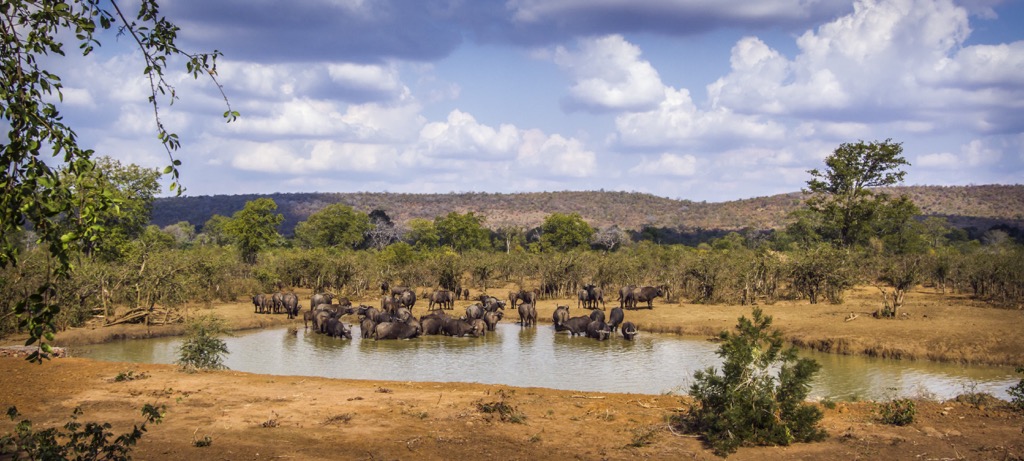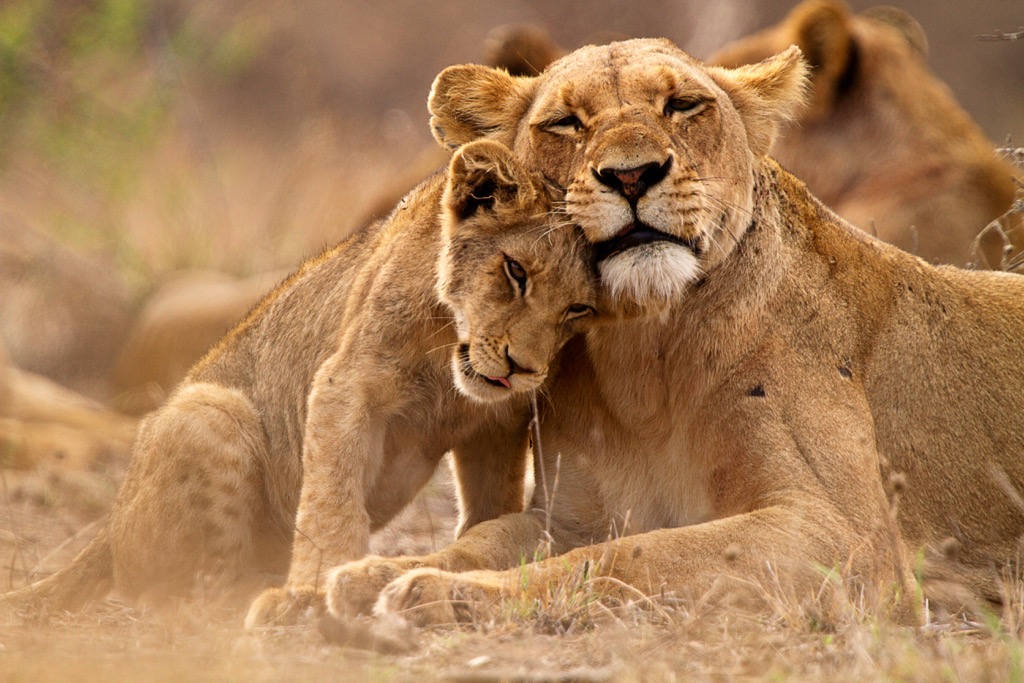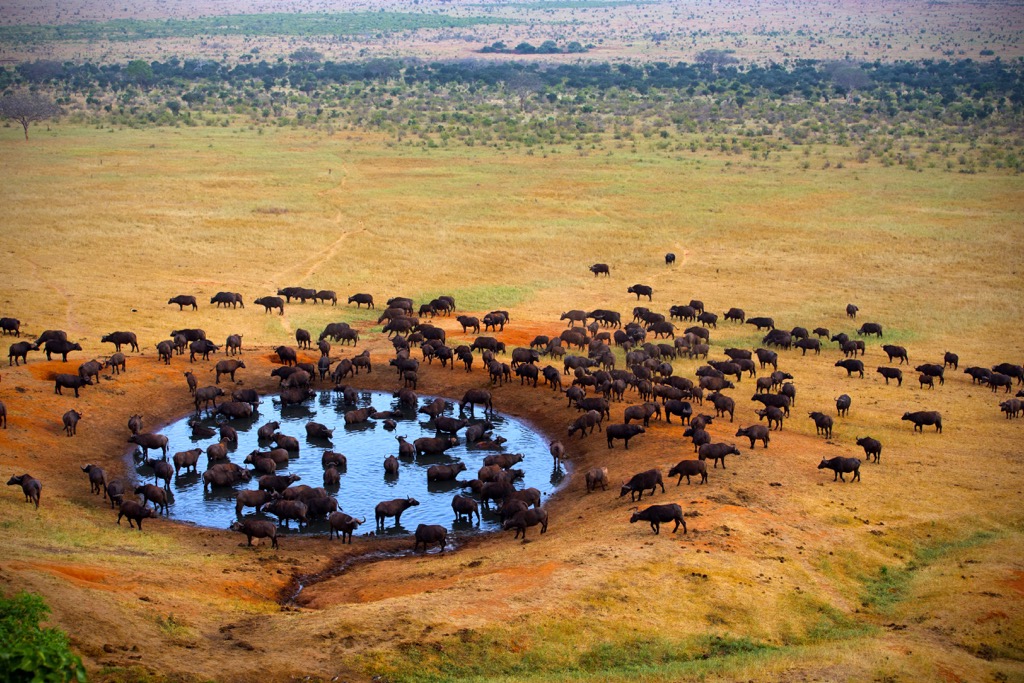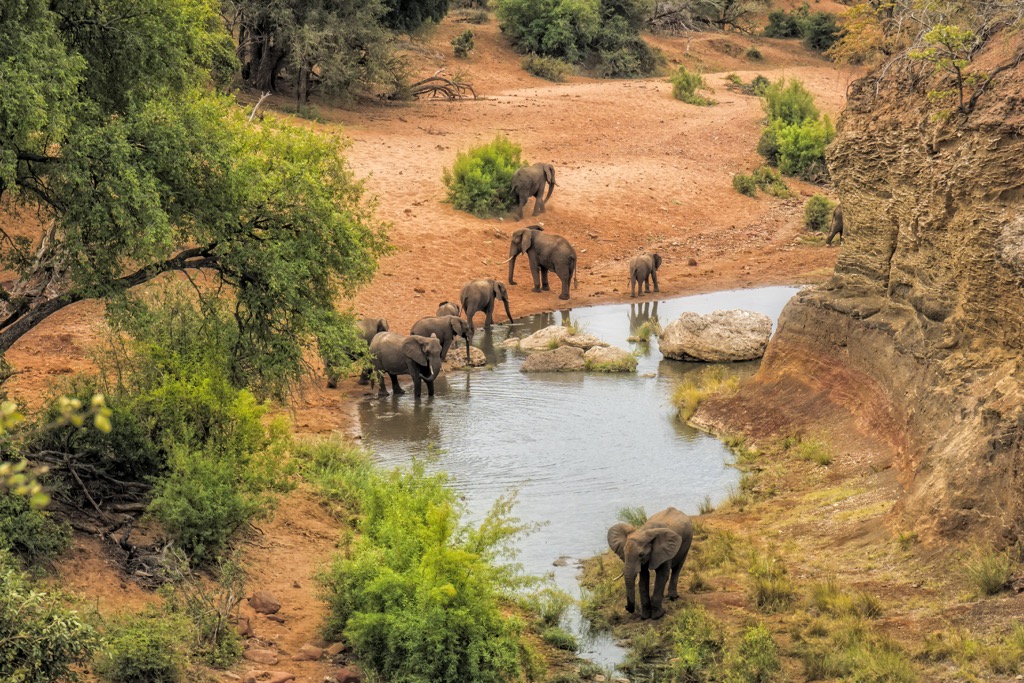Get PeakVisor App
Sign In
Search by GPS coordinates
- Latitude
- ° ' ''
- Longitude
- ° ' ''
- Units of Length

Yes
Cancel
Share ×

Scan the QR code and open PeakVisor on your phone
❤ Wishlist ×
Choose
Delete
South Africa's Kruger National Park is one of the world’s preeminent conservation areas, founded in 1898 to protect the ‘prehistoric’ state of African ecological beauty that still existed in this corner of the nation. Already one of the continent’s more extensive game reserves, the park is in the process of joining the Great Limpopo Transfrontier Park, which would be the fourth-largest National Park globally. Naturally, the park contains many of the so-called Big Five African mammals; lions, leopards, elephants, rhinos, and buffalos all make their home here, as well as hundreds of other fascinating species. Unbeknownst to many people, the park also straddles mountains. There are 153 named peaks in Kruger National Park; the highest and most prominent is Khandzalive (840 m / 2,756 ft).
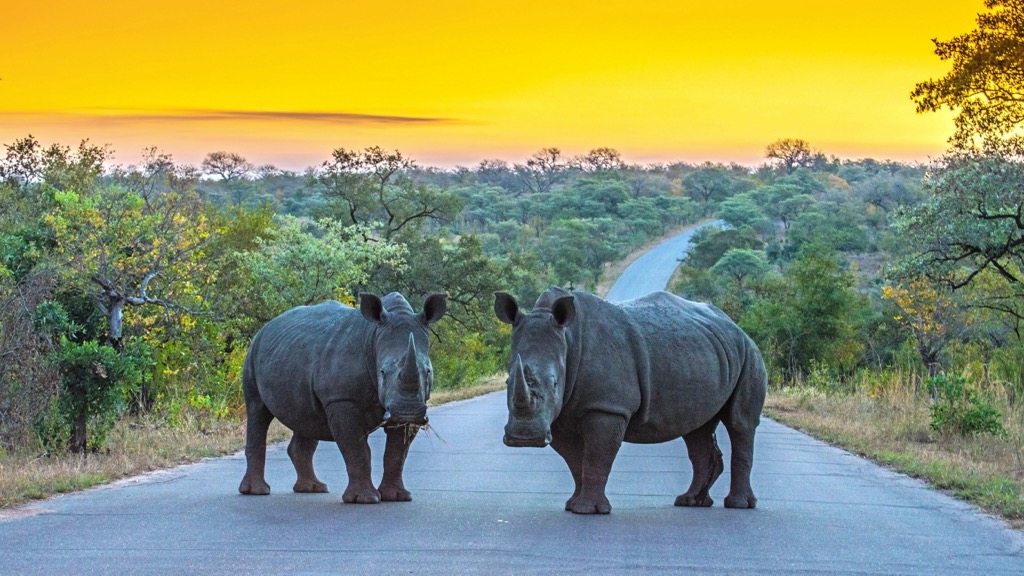
Kruger National Park occupies the northeastern tip of South Africa, sharing a boundary with the nations of Mozambique and Zimbabwe. Kruger’s southern boundary is about 20 km (12.2 mi) north of the small nation of Eswatini, but their borders do not touch. It is in the Limpopo Province in the north, and the Mpumalanga Province in the south.
Kruger National Park is extensive, although perhaps not by African standards. Across the African continent, more than 200 national parks cover 8.6% of the African landmass. Some of these, like the Namib-Naukluft National Park in Namibia, are more than twice the size of Kruger. Nevertheless, Kruger is massive, spanning 19,623 km2 (7,576 sq mi) and occupying about 3% of South Africa’s territory.
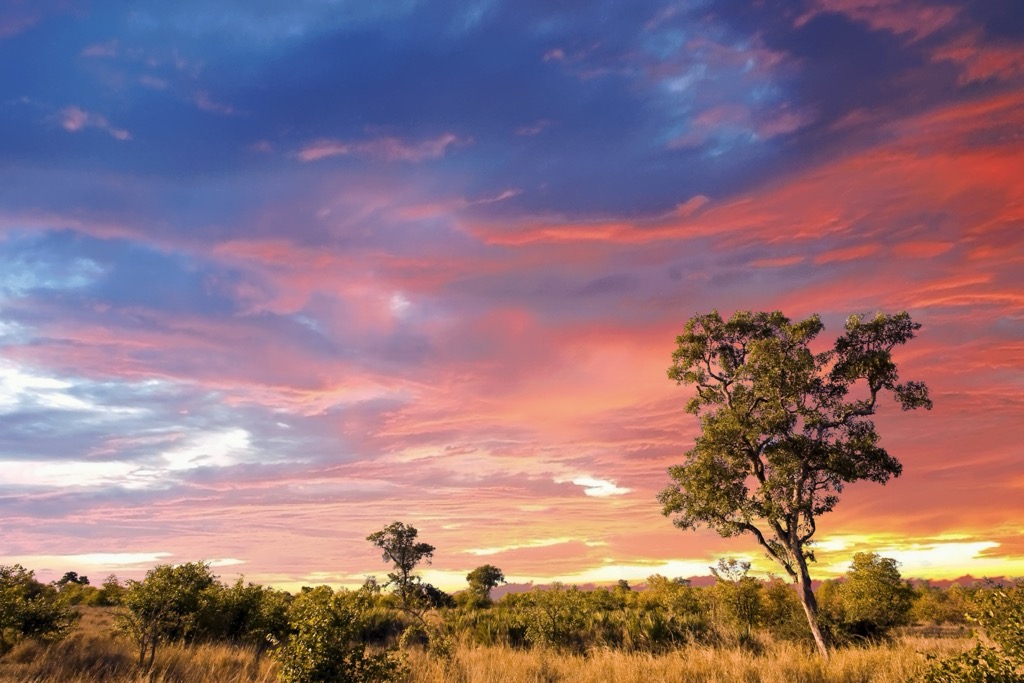
Even more massive is the Great Limpopo Transfrontier Park, which plans to link Limpopo National Park (Mozambique), Banhine National Park (Mozambique), Zinave National Park (Mozambique), Gonarezhou National Park (Zimbabwe), and Maputo Elephant Reserve (Mozambique). The combined area will likely be over 35,000 km2 (13,513 sq mi).
Kruger occupies an incredible rural area, which is why it’s feasible to designate a park as large as the Great Limpopo Transfrontier Park; there are no major population centers to avoid. The nearest town of significant size is Mbombela, which serves as a gateway to the park. The nearest large city is Maputo, Mozambique's capital and largest city. Johannesburg/Pretoria is the next closest city and probably the destination for international travelers due to its large airport (O.R. Tambo International).

Kruger itself is not particularly mountainous. Still, the park is surrounded by mountains, dramatically influencing its overall ecology, which I’ll discuss in the Geology and Ecology sections. These ranges surround the park:

Kruger is often described as ‘Lowveld,’ which basically translates to ‘low elevation bushlands.’ The region sits below the surrounding mountains at altitudes between 200 and 900 meters. The park is also relatively arid, with precipitation between 20 and 90 cm per year. But what is the landscape actually like? The following are the main landscapes that define the Kruger National Park Lowveld:
Savannah: Like in many African game reserves, savannahs and grasslands dominate much of the landscape. These open plains are ideal for herbivores like zebras, wildebeests, and impalas, which, in turn, attract predators like lions, leopards, and cheetahs. They also happen to be perfect for human viewing of said wildlife.

Wetlands: Several swamps and wetland areas exist within the park, including the Mopani Rest Camp and the northern Pafuri regions.

Rivers: Kruger National Park is crisscrossed by numerous rivers and watercourses, including the Limpopo, Sabie, Crocodile, and Olifants Rivers. These waterways provide essential water sources for wildlife and create lush riparian zones rich in vegetation and biodiversity. More than 3,000 Nile crocodiles reside in the park’s rivers and wetlands.

Woodlands: The park also features woodland areas, though they differ from the northern hemisphere's vast temperate forests and the equatorial regions' tropical forests. Still, these woodlands are home to over 300 tree species, usually low to medium height.

Mountains: The northern regions of the park, bordering Zimbabwe and Mozambique, include the Soutpansberg range. The Lebombo Mountains and the foothills of the Drakensbergs characterize the Southern portion. Khandzalive (840 m / 2,756 ft), the highest peak, is located in the park’s southeastern corner.

Kruger National Park is less geologically diverse than many of the mountainous places we feature on our PeakVisor website. Nevertheless, geological processes have largely determined the park’s ecological composition, specifically its ideal habitat for big game animals.
Approximately 130 million years ago, the landscape of the Lowveld region in South Africa underwent geological transformations due to continental plate movements. These shifts resulted in tilting and subsequent erosion, leading to the formation of the present-day topographical features and impacting the habitats and ecosystems that define Kruger.

Granite Gneiss/Schist: The western side of the Lowveld, descending from the Northern Drakensberg plateau, consists primarily of granite gneiss and schist. These rocks create a landscape of small rocky outcrops, known variably as Inselbergs, Koppies, or Kopjes (dutch). The soils derived from these rocks tend to be acidic and nutrient-depleted.
Basalt and Clays: The geological composition changes to basalt and clays moving eastward from the Drakensbergs. The transition from granite to basalt and clays is marked by a noticeable flattening of the Lowveld savanna, transitioning from rocky outcrops to open grassland plains. These soils are comparatively nutrient-rich, fostering the growth of lush vegetation and, consequently, more wildlife.
Rhyolites: Further to the east, the landscape is dominated by the Rhyolite formations that make up the Eastern Lebombo Mountains.

The Drakensberg range formed about 180 million years ago as a result of rifting tectonics in response to the breakup of the supercontinent Gondwana.
Meanwhile, the Soutpansberg Mountains are 1.8 billion years old; they aren’t much more than large rolling hills at this point. ‘Soutpansberg’ means Salt Pan Mountains in Afrikaans, referring to the abundance of salt running down these hills into the park’s territory.

Most of the violence, racial segregation, and hatred defining South Africa's last couple hundred years is the product of vast mineral resource wealth. Once white prospectors discovered gold, it was a race to subdue the black population for control of the mines and profits. Whites also fought each other; Dutch settlers waged war with English settlers during the two Boer Wars.
Fortunately for Kruger, no significant deposits were discovered before the region became a national park. Kruger’s greatest resource was always its creatures, but those were nearly overhunted as well by the late 19th century.
Kruger’s biggest threat is now from poachers seeking rhino horn, which has been falsely sold as a miracle cure for a variety of ailments, mainly among the newly wealthy of Vietnam. In the past ten years, rhino populations in Kruger have decreased by 75%. During the height of the poaching, almost two rhinos were killed per day in South Africa. Poaching has declined mostly because finding new rhinos to kill has become significantly more complicated. Additionally, park staff is de-horning rhinos in advance to prevent killings.

The ecology of Kruger National Park is exceptionally diverse and complex, making it one of Africa's premier wildlife conservation areas. Specifically, the Great Limpopo Transfrontier Park is home to more than 850 animal and 2,000 plant species, although not all of these species are present in Kruger.
Kruger’s climate varies throughout the park’s massive territory, ranging from subtropical to semi-arid. The mountainous regions in the north and south receive 50-100 cm (20-40 in) of rainfall per annum, while the lowveld in the middle of the park scrapes by with 10 cm (8 in).
All regions of the park are characterized by a wet and dry season. The wet season occurs during the summer between October and April when temperatures range between 30-40+℃ (86-104℉). Precipitation mainly falls as intense afternoon thundershowers. Viewing wildlife during this time can be difficult because the animals spread out, no longer constricted by specific water sources. Moreover, an abundance of grasses and foliage can obscure views.

However, summer showers facilitate insect explosion, increasing bird activity amongst many species. Birders may want to visit during this time.
The dry season occurs during meteorological winter between May and September. The park receives very little precipitation during this time. There are several reasons why the dry season is the best time to visit Kruger:
Kruger is still a year-round destination, and you’ll see plenty of wildlife no matter when you go.

Kruger National Park is famous because it is a biodiversity hotspot for animals. According to the national park’s website, there are 147 species of mammals, 114 reptile species, 51 snake species, 49 fish species, and 508 species of birds permanently settled in the park.
However, Kruger is not a true biodiversity hotspot for plant species. For example, the Fynbos ecosystems of the Western Cape region contain more than 9000 plant species, with ⅔ of those endemic. Kruger, on the other hand, is home to a more modest but still impressive 2000 species.

Whereas its array of wildflowers defines the Fynbos ecoregion, Kruger is a land of tall grasses and trees. Some common grass species in the park include Red Grass (Themeda triandra), Natal Red Top (Melinis repens), Buffalo Grass (Panicum maximum), and Spear Grass (Heteropogon contortus).
Kruger’s melange of trees (330 species) is even more distinctive. Most people already know of the celebrated Boabab Tree (Adansonia digitata), which features an enormous trunk and relatively little foliage and can live to be more than 1,000 years old. Other notable tree species include Leadwood (Combretum imberbe), Marula (Sclerocarya birrea), and Mopane (Colophospermum mopane).

While a naturalist would be content to come and study just the trees of Kruger, everybody else comes to see animals. The park includes all the most famous mammals, including the African Elephant (Loxodonta africana), Buffalo (Syncerus caffer), Lion (Panthera leo), Leopard (Panthera pardus), and Cheetah (Acinonyx jubatus).
Both white and black rhinos remain park residents but are viciously targeted by poachers. Less than 3,000 remain. An elusive resident is the Honey Badger (Mellivora capensis), the subject of a viral YouTube video from a few years ago. One of the park's most endangered mammals is the African Wild Dog (Lycaon pictus); only an estimated 400 individuals remain in South Africa.

Kruger’s bird species include colorful specimens like the lilac-breasted roller, plum-colored starling, and black-headed oriole. Birds of prey include the bateleur eagle, the martial eagle (the largest in Africa), and owls like the Scops Owl and the Eagle Owl (the largest in the world).

Kruger National Park is a highly intact ecosystem. The park is home to many tertiary, or apex, predators. Species like lions and leopards occupy the top of the food chain and command visitors' attention. However, One of Kruger's most remarkable aspects is that all trophic levels function seamlessly to form a complex ecosystem in which each species occupies its exact niche and plays a distinct role. All ecosystems work like this, but in Kruger, it’s more visible to us than anywhere else in the world.
The abundant savannah and grasslands support large ungulate populations, supporting astounding numbers of predators (1,000 leopards, 1,700 lions).

Like the Fynbos of the Cape Floral Region, fire is a natural and essential ecological process in Kruger. It rejuvenates grasslands, clears undergrowth, and releases nutrients into the soil. While wildfires do occur, park management often uses controlled burns to mimic natural fire regimes.

Human presence in Kruger and southern Africa generally dates back about 1.5 million years. The earliest human ancestors evolved in this region, including the territory of Kruger. Eventually, Homo sapiens became dominant.
San bushmen settled in the region about 100,000 years ago and subsisted as hunter-gatherers until 200 AD, when the first Nguni speaking speak arrived in search of lands for their cattle. San Peoples were never entirely extirpated from Southern Africa, and many still inhabit South Africa, Zimbabwe, Angola, Botswana, and Namibia (mostly Botswana and Namibia) and maintain a traditional lifestyle.

Kruger remained sparsely populated, as the region was poorly suited for livestock grazing. The frequent presence of TseTse flies and the large number of predators limited animal husbandry. Kruger became a popular hunting zone as European Caucasians began colonizing southern Africa after discovering gold (late 19th century).
By the late 19th century, hunters began realizing the savannahs around Kruger were extremely overhunted, and game populations were dwindling. Gold prospectors had effectively decimated the white rhino population (none remained in 1918) and the elephant population (65 remained in 1918). Impala were reduced to 6,500 individuals. For comparison, there are now 2,800 white rhinos, 13,000 elephants, and 136,000 impala in the park.
The area was declared a game reserve in 1898 and a National Park in 1926. Although initially designated solely to restore wildlife populations, the park began hosting tourists in 1927. The park proved popular, and tourist visits grew throughout the following decades. The 60s proved to be a defining decade, and with the improvement of many park roads, Kruger stayed open throughout much of the year (not just the dry season). White rhinos were reintroduced in 1961 after having been extirpated in 1896. Black rhinos were brought in in 1971 (extirpated since the 1940s).

Since the 2000s, the park has seen a severe uptick in rhino poaching due to intense demand for rhino horns in southeast Asia, particularly Vietnam. Over 10,000 rhinos have been poached in the last decade, and the population of white rhinos has been reduced to 2,800 individuals. All animal populations, including rhinos, have made remarkable comebacks over the last century (there were none in the park 100 years ago).
Kruger now sees 1.8 million visitors per annum and has over 10,000 employees. There are also several private game reserves surrounding the park that offer various experiences to tourists. Currently in the works is the Great Limpopo Transfrontier Park, which plans to link Limpopo National Park (Mozambique), Banhine National Park (Mozambique), Zinave National Park (Mozambique), Gonarezhou National Park (Zimbabwe), and Maputo Elephant Reserve (Mozambique). The combined area will likely be over 35,000 km2 (13,513 sq mi).
Kruger National Park in South Africa is primarily known for its game drives on open-top 4x4 vehicles. However, it also offers some excellent hiking opportunities that allow visitors to explore the park's diverse landscapes and wildlife on foot for a far more intimate and worthwhile experience. Because the park is filled with predators, hiking is only possible in guided groups with armed park rangers. There are Wilderness Trails and Backpacking Trails, the difference being what visitors carry and designated lodging each night. Visitors must book hiking experiences well in advance; these trips sell out quickly. Adhering to your guide's instructions is essential - this is a wild environment.

Here are a few of the hikes in Kruger:
This is a backpacking trip commencing at Mopani Rest Camp and spanning a vast wilderness region between the Letaba low water bridge and the Mingerhout dam along the Letaba River.
The four-day, three-night journey is available for departure every Wednesday and Sunday from February 1st to November 30th (dry season only). Trail leaders can determine when and where to set up camp and which paths to follow.
Hikers can safely park their vehicles at Mopani Rest Camp in the designated parking area. The trail is led by two experienced Trails Rangers, with a maximum of eight participants per trail and a minimum requirement of four individuals. Participants are responsible for bringing their camping gear and sustenance for the duration of the journey, as no overnight huts are available.
The park’s website is adamant that this is a true backcountry adventure. Safety is a top priority; all hikers must use tents and camp each night while on the trail. Setting up tents and preparing meals are the responsibility of each participant. No waste bins or restroom facilities are provided at the overnight stops, and the trail operates under a strict "pack it in, pack it out" policy while adhering to the "leave no trace" camping ethos.
The Mphongolo Trail is a similar backpacking route beginning at the Shingwedzi Camp rather than the Mopani Camp.

Nayaland is one of Kruger's most renowned wilderness trails. It's a four-day guided hike in the remote northern wilderness of the park. Along the way, you'll experience pristine Lowveld wilderness and a chance to see wildlife up close. The trail is in a remote and secluded destination between Punda Maria camp and Pafuri, featuring the Lanner and Levhuvhu gorges along the Levhuvhu River. It follows the Madzaringwe River, with the imposing cliffs of the Soutpansberg Mountains providing a backdrop.
The area is renowned as one of the finest birdwatching spots in the country, featuring scarce sandveld and dryland vegetation communities. The abundant giant baobab trees make it one of the most remarkable trails within Kruger National Park. One of the trail's notable features is the presence of culturally significant sites, including Zimbabwe stone structures and San rock art.
Booking well in advance is necessary.
Located in the northern region of Kruger, the Bushman Trail offers a guided experience that delves into the history and culture of the San People (Bushman). It's an opportunity to learn about their traditional hunting and survival skills.
Located in the park's central region, the Napi Wilderness Trail offers a three-day guided hike exploring the Napi and Pioneer Rivers. It's ideal for birdwatching and chances to see big game.

Cities in southern Africa have a reputation for crime and violence that is not without reason. You have to be careful here. Nevertheless, as one local explained in so many words, “South Africa is a wild place, but the US is truly deranged.” It was right after the Newtown school shooting that killed 26 elementary school children in Connecticut. His point was that, in South Africa, you might be mugged but unlikely to be subjected to meaningless, disturbing violence.

Johannesburg and Pretoria, situated in South Africa's Gauteng Province southwest of Kruger, are two major urban centers of commerce, culture, and governance. Despite their proximity, they exhibit distinct characteristics and roles. Johannesburg, often called 'Joburg' or 'Jozi,' is South Africa's largest city and a dynamic economic hub. In contrast, Pretoria, also known as 'Tshwane,' functions as the administrative capital - one of three South African capitals - hosting key government institutions.
Most tourists will focus on Johannesburg, the more vibrant city of the two. Joburg features a flourishing arts community, a well-established café culture, and the bustling township of Soweto, South Africa's most populous township. The city is alive with entertainment options; Trevor Noah, one of the world’s greatest modern entertainers, hails from here (his book is called Born A Crime). The dynamic live music scene makes Johannesburg the ultimate nightlife destination in the country (Sounds of Soweto).
Joburg has experienced a revival in the last decade, but there is still a lot of crime, and you should watch out. Don’t carry too much money on your person - getting mugged is the worst that is likely to happen. Violence against tourists is rare. The city has a surprisingly friendly and open vibe.

Maputo is Mozambique's capital and largest city and is 90 kilometers away (55 mi) from the South African border.
The city is lively, with people going about their daily lives rather than the bustle of tourism that plagues much of the world today. The ambiance exudes a sense of vitality and well-being.
What stands out are the numerous buildings with a vintage charm, often accompanied by gardens teeming with cycads, coleus, flamboyant trees, jacaranda, and bougainvillea. The city showcases colonial Portuguese influences; notably, Maputo boasts exceptional architectural creations by Pancho Guedes, characterized by their Gaudíesque and surreal designs. Maputo offers various accommodation options, including high-end hotels and comfortable backpacker hostels.

Mbombela is a gateway for tourists to journey to Kruger National Park and Mozambique. Other attractions worth exploring are the Sudwala Caves and God's Window, situated within the Blyde River Canyon Nature Reserve. God's Window is a lookout point that offers a panoramic vista of the iconic Drakensberg Escarpment. There isn’t too much of note in Mbombela itself, but the Lowveld National Botanical Garden might interest some visitors.

Explore Kruger National Park with the PeakVisor 3D Map and identify its summits.
